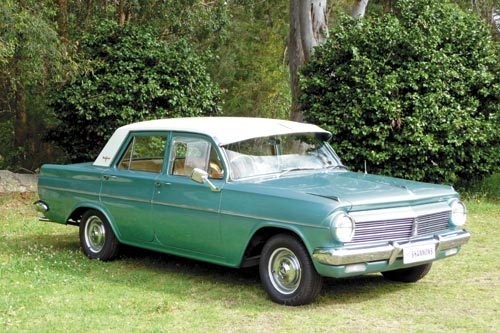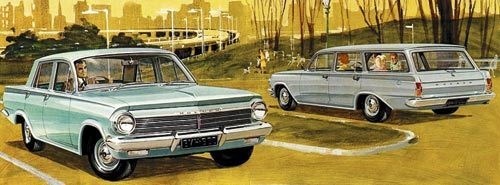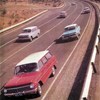Holden EH: Buyers Guide
 Holden EH
Holden EH

 Holden EH
Holden EH

 Holden EH
Holden EH

 Holden EH
Holden EH


|
|
Holden EH
|

|
|
Holden EH
|

|
|
Holden EH
|

|
|
Holden EH
|
The car that introduced the Holden Red engine. Many consider the EH as the car that brought GMH into the modern era...

|
|
Buyer's Guide: Holden's much-loved EH
|
Holden EH
With almost 257,000 built, the EH Holden remains a regular sight on our roads and a perennial favourite with true-blue collectors.
In August 1963 -- almost 15 years after the launch of 'Australia's Own' car -- Holden finally delivered a model that could stand proudly amid the cream of six-cylinder family sedans from around the world.
For most of the preceding 15 years, Australian car buyers had doggedly and loyally bought Holdens; delivering more than half the local new-car market to General Motors. This was despite the products they were offered being drably styled, technically inferior and powered by turgid 'grey' engines.
![EHwagon 01[1]](https://assets.primecreative.com.au/s3/cougar-assets/momo-media/8437428/ehwagon01-1-.jpg)
Then came Ford's ultra-modern Falcon and the performance oriented Chrysler Valiant, giving GM-H, for the first time in its existence, some serious competition.
By 1960 Holden recognised that its previously unassailable position was under threat and set about reassessing its approach to the Australian market. First indication of our leading car-maker's more enlightened philosophy was the lighter, smaller EJ that arrived in July 1962 and was accompanied by a luxurious Premier version.
Just 15 months later, GM-H dealers across the country whipped back the covers to reveal a car which, while resembling the EJ, shared hardly a panel with its predecessor and was powered by an engine that would become a cornerstone of Holden's success into the 1970s.
During 19 months of production, an extraordinary 257,000 EHs were sold into a market of just 11 million people. To match that level of acceptance in 2004 Australia, Holden would need to be building almost 25,000 Commodores per month.
The overhead valve, six-cylinder 'red' engine announced in conjunction with the EH came in two versions; a 2.6-litre '149' with 75kW and 2.9-litre, 86kW '179'. The 179 was initially offered only with automatic transmission and it took until April 1964 for the three-speed 179M became freely available. Top speed of the big-engined manual was 156km/h and 0-60mph (0-97km/h) acceleration took 13.4secs.
![EHwagon 02[1]](https://assets.primecreative.com.au/s3/cougar-assets/momo-media/8437435/ehwagon02-1-.jpg)
Even more potent were the 120 'S4' cars built to contest the 1963 Bathurst 500. Although several of them lost time after breaking wheels, the entry of Frank Morgan and Ralph Sach finished second outright behind the Cortina GT of Harry Firth and Bob Jane. An S4 tested by 'Wheels' magazine for its December 1963 issue reached166km/h.
S4s also contested touring car events during 1964; those consistently quickest being the entries of Brian Muir and Norm Beechey. However, the car became redundant as front-running drivers switched to V8s and EHs didn't again feature prominently on the racetrack until the emergence of an Appendix J historic category during the 1980s.
The leather-trimmed Premier had been Holden's flagship since the EJ's appearance in July 1962. EJ Premiers were built only as sedans with automatic transmission but the EH range included a Premier wagon and gave drivers the option of shifting their own gears.
The EH also saw GM-H dramatically expand its list of accessories and options, allowing buyers to personalise their cars to a degree that would have been unthinkable five years earlier.
During the six years it took Trevor Sedgman to complete his magnificently-restored Premier wagon, he scoured swap meets and friends' garages for 'extras' that would make his EH unique. His car now incorporates an impressive array of Nasco options including power steering, venetians, scratch plates, an additional parcel shelf and a clock.
![EHwagon 03[1]](https://assets.primecreative.com.au/s3/cougar-assets/momo-media/8437442/ehwagon03-1-.jpg)
Sedgman's car had sat unloved and rusting in a front yard for several years before being rescued and his advice to anyone considering a ground-up EH restoration is simple.
"Have a set plan, label everything you remove and make a list of parts you need to replace," he said. "Labelling takes time but think of the time you will save when it comes to reassembling -- especially if it takes six years like I did with mine."
ON THE ROAD
EH Holdens selling in today's market are almost evenly divided between those that remain in basically original condition and cars which have been modified to a significant degree.
At the risk of offending those owners who have taken the valid and often costly decision to preserve the authenticity of their cars, I have to confess a preference for the ones that have undergone sensible upgrades to maintain their viability under 21st Century driving conditions.
![EHwagon 08[1]](https://assets.primecreative.com.au/s3/cougar-assets/momo-media/8437568/ehwagon08-1-.jpg)
In standard trim, the EH comes with unyielding, vinyl-trimmed bench seats, appallingly skinny tyres, three-speed automatic or manual transmission and drum brakes. For people who during the 1960s had traded their earlier model on an EH, the difference in handing, steering response and performance would have been astounding but today the car in standard condition feels skittish and unwieldy.
Wider steel or mag wheels with radial-ply tyres are the cheapest and easiest way to exploit the EH model's excellent chassis balance. Improving braking to match the performance of 179 models is equally straightforward; using disc brakes from HR or later models.
Twin carburettor conversions and modified cylinder heads for Holdens have been available for years and these have found their way onto a goodly number of EHs. Owners have also discovered that the later and larger 186 or 202 engine with a set of triple Stromberg carburetors, as used by the Torana XU-1, provide a very useful and usable performance boost.
From there it is easy to fit a four-speed Holden or five-speed Toyota gearbox and create, for a minimal investment, the 180km/h EH.
Interior and boot space, plus astonishing durability, are inescapable attributes of the EH. The combination of broad, bench seats and generous legroom ensure that six full-sized Australians can travel in reasonable comfort, while the large and well-shaped windows and decent ventilation allow them all to enjoy journey.
BUYING
There is absolutely no excuse for being unable to find an EH to suit your expectations and budget. It is likely that at least five per cent of the cars built still survive in usable condition and prices range from $1000 to more than $20,000.
![EHwagon 04[1]](https://assets.primecreative.com.au/s3/cougar-assets/momo-media/8437607/ehwagon04-1-.jpg)
In common with most high-profile Australian classics, values for EH Holdens have strengthened noticeably during the past 18 months. Recent surveys of the market reveal mildly modified Special sedans in very good condition at up to $8000 and a selection of daily-driver cars in the vicinity of $5000. Two years ago, EHs in these categories would have been selling for $6000 and $3500 respectively.
Premiers have historically been priced 30 per cent above Standard and Special models, so it's not surprising to see the bulk of available Premiers now offered at more than $8000. Up to $15,000 is available for fully restored Premiers and more than $20,000 for highly modified cars in trophy winning condition.
Utilities and panel vans are scarce and in excellent condition worth 10-15 per cent more than a Special sedan in equivalent order.
BUYERS CHECKLIST
Body![EHwagon 05[1]](https://assets.primecreative.com.au/s3/cougar-assets/momo-media/8437449/ehwagon05-1-.jpg)
The EH Holden was in many respects its own worst enemy. Owners regarded the car as immortal and maintenance -- especially of the body -- was often neglected. Rust attacks almost everywhere but most noticeably the wheel arches, lower door skins, sills, cabin and boot floors, the trailing edges of mudguards, wagon and utility tailgates. Virtually everything needed to restore an EH is available second-hand and some reproduction panels are available new, as are door and window seals. Genuine NOS (new old stock) items are pricey if the $1400 paid for a pair of brand new mudguards on an internet auction site are any indication. Genuine accessories like exterior mirrors and wheel spats will add to a car's value.
Engine
Red Holden engines of all persuasions seemingly survive forever. Keep them oiled and watered and avoid pushrod-bending over revs and they'll go for 250,000km before needing a rebuild. Even then; rings, bearings, a valve regrind and perhaps a new harmonic balancer aren't beyond the capabilities of the home mechanic with a spare weekend and Repco account. Hot camshafts, seriously modified cylinder heads, multiple carburettors and turbochargers will complicate the task but these are still one of the easiest engines in the world to maintain. Serious oil leaks and cracked exhaust manifolds will need immediate attention.
Transmission
The standard three-speed Holden manual gearbox is stronger than the proverbial ox. Bearing noise is common and chipped teeth on the non-synchromesh first gear often encountered. Replacements for the original HydraMatic auto transmission are difficult to locate and some cars have been converted to use the later Trimatic. Club sources recommend this conversion is accompanied by replacing the original rear axle ratio with a higher 3.36:1 diff centre. Vibration under load is usually traced to an out of balance tailshaft.
![EHwagon 06[1]](https://assets.primecreative.com.au/s3/cougar-assets/momo-media/8437630/ehwagon06-1-.jpg)
Suspension & Brakes
Worn kingpins and steering linkages will contribute to vague steering and front end vibration. Replacement parts are available or the entire unit can be replaced by the ball-joint front end -- with disc brakes if required -- from an HR model. Beware cars that have been lowered by having their coil springs shortened. Rear leaf springs flatten with age and can crack. The standard drum brakes are adequate at best and cars with later-model disc front brakes and a power booster are advisable if they are to be frequently used.
Interior & Electrics
Replacement seat trim and door trims for Special and Standard models are available but original-pattern hoodling is not. A vinyl retrim will cost $2000-2500. Refinishing a Premier in correctly-patterned leather will cost $4000+. Gemini or Camira bucket seats can be used to replace the original bench seat. Electrics are simple and reliable.
![EHwagon 07[1]](https://assets.primecreative.com.au/s3/cougar-assets/momo-media/8437637/ehwagon07-1-.jpg)
SPECIFICATIONS
Holden EH
Production: 256,959
Body: Steel integrated body/chassis; sedan, station wagon, utility, panel van
Engine: 2.6 or 2.9 litre in-line six-cylinder with overhead valves and single downdraft carburettor
Power & Torque: 75kW @ 4400rpm (2.6), 86kW @ 4000rpm (2.9), 145Nm @ 2000rpm (2.6) 237Nm @ 1600rpm (2.9)
Performance: 0-100km/h 14.2secs, 0-400m 18.8secs (2.9)
Transmission: three speed manual or three-speed automatic
Suspension: Front: independent with coil springs, wishbones, telescopic shock absorbers and anti-roll bar Rear: live axle with semi-elliptic springs and telescopic shock absorbers
Brakes: four wheel drums -- power assistance optional
Wheels & Tyres: 13 x 4.5 steel, 640 x 13 crossply
Price range: $500 - $15,000
Contact: EH Holden Clubs in most states. Web site: www.ehholden.com.au
Unique Cars magazine Value Guides
Sell your car for free right here
Get your monthly fix of news, reviews and stories on the greatest cars and minds in the automotive world.
Subscribe

.jpg)














